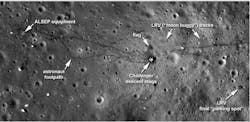Wide-angle camera captures sharper images of moon landing sites
A camera onboard NASA's Lunar Reconnaissance Orbiter (LRO) has captured the sharpest images ever taken from space of the Apollo 12, 14, and 17 landing sites on the moon.
According to Arizona State University researcher Mark Robinson, the principal investigator for the Lunar Reconnaissance Orbiter Camera (LROC), the images from the camera have provided a much sharper view of the rover tracks at the Apollo 17 site. In previous images the rover tracks were visible, but now they are sharp parallel lines on the surface.
The high-resolution images were captured due to adjustments made to LRO's orbit, which was lowered from its usual altitude of approximately 31 miles (50 km) to an altitude that dipped to nearly 13 miles (21 km) as it passed over the moon's surface.
The spacecraft remained in this orbit for 28 days, long enough for the moon to completely rotate, allowing for full coverage of the surface by LROC's wide-angle camera that can capture images at a scale of 100 m/pixel in seven color bands over a 60-km swath.
At each site, trails can be seen that run to the west of the landers, where the astronauts placed the Apollo Lunar Surface Experiments Package (ALSEP) to monitor the moon's environment and interior.
This ALSEP equipment was a key part of every Apollo space mission. It provided the first insights into the moon's internal structure, measurements of the lunar surface pressure, and the composition of its atmosphere. Apollo 11 carried a simpler version of the science package.
The images show distinct trails left in the moon's thin soil when the astronauts left their lunar modules and explored the moon on foot. In the Apollo 17 image, the foot trails, including the last path made on the moon by humans, are easily distinguished from the dual tracks left by the lunar rover, which remains parked east of the lander.
-- Posted by Vision Systems Design
